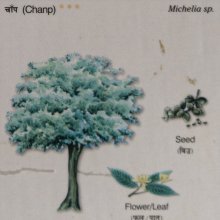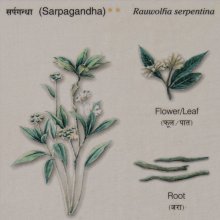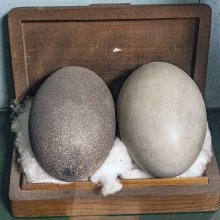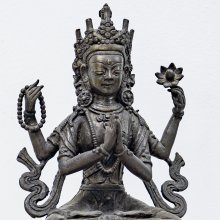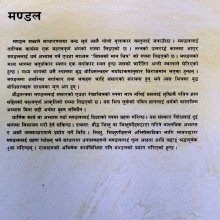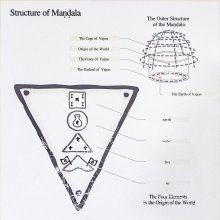Phula, Phūla, Phulā: 4 definitions
Introduction:
Phula means something in Buddhism, Pali, Marathi, Hindi. If you want to know the exact meaning, history, etymology or English translation of this term then check out the descriptions on this page. Add your comment or reference to a book if you want to contribute to this summary article.
Alternative spellings of this word include Fool.
Images (photo gallery)
(+1 more images available)
In Buddhism
Tibetan Buddhism (Vajrayana or tantric Buddhism)
Source: OSU Press: Cakrasamvara SamadhiPhula (फुल) refers to one of the “four mountains” (Parvata), according to the Guru Mandala Worship (maṇḍalārcana) ritual often performed in combination with the Cakrasaṃvara Samādhi, which refers to the primary pūjā and sādhanā practice of Newah Mahāyāna-Vajrayāna Buddhists in Nepal.

Tibetan Buddhism includes schools such as Nyingma, Kadampa, Kagyu and Gelug. Their primary canon of literature is divided in two broad categories: The Kangyur, which consists of Buddha’s words, and the Tengyur, which includes commentaries from various sources. Esotericism and tantra techniques (vajrayāna) are collected indepently.
Languages of India and abroad
Marathi-English dictionary
Source: DDSA: The Molesworth Marathi and English Dictionaryphūla (फूल).—n (phulla S) A flower or a blossom. 2 A spark (esp. from iron or from fireworks). 3 Nap or down (of cloth). 4 pl White spots covering the body (of cows, horses &c.) 5 A whitish exfoliation upon stones or wood in rainy weather. 6 A white speck in the eye, albugo. 7 A certain wild plant. 8 The soot or condensed smoke of ūda or frankincense. 9 Pewter puffed by the action of fire. 10 Fine cuttings of betelnut. 11 An ignited drop of oil caused to fall from a bibwa or marking nut. 12 A medicinal preparation from Onwa (Ligusticum Ajwaen). 13 That region of the womb in which the conception is supposed to be formed, the ovarium. Understood popularly of the Womb. v paḍa, vāṅkaḍēṃ paḍa. phulānta ghālūna (rākhaṇēṃ, ṭhēvaṇēṃ, nēṇēṃ &c.) To keep, carry &c. with extreme heedfulness and care; to lay up in lavender. Pr. phulēṃ vikalīṃ tēthēṃ gōṃvaṛyā vikaṇēṃ To do dirty deeds in the place of former deeds of sweet savor. phūla calaṇēṃ g. of s. To suffer prolapsus or displacement of the vagina. phūla dēṇēṃ (divyāsa) To extinguish (a lamp or light). phūla nāhīṃ phulācī pākaḷī dēṇēṃ (To give a petal when unable to give a whole flower.) To give according to one's ability. phūla bāhēra paḍaṇēṃ-nighaṇēṃ To be divulged or disclosed--a secret matter. (Lit. To open out, from the bud, into the flower.) phūla vāhaṇēṃ (To present a flower unto). To offer a female in marriage.
Source: DDSA: The Aryabhusan school dictionary, Marathi-Englishphūla (फूल).—n A flower. A spark. Nap or down (of cloth). pl White spots cover- ing the body (of cows, horses &c.). A white speck in the eye, albugo. Anything resembling a flower in appearance. phulānta ghālūna (rākhaṇēṃ, ṭhēvaṇēṃ nēṇēṃ &c.) To keep, &c. with extreme heedfulness and care. Pr. phulēṃ vikalīṃ tēthēṃ gōvaṛyā vikaṇēṃ To do dirty deeds in the place of former deeds of sweet savour. phūla nāhīṃ phulācī pākaḷī dēṇēṃ To give according to one's ability. phūla bāhēra paḍaṇēṃ-nighaṇēṃ To be divulged or dis- closed-a secret matter.
Marathi is an Indo-European language having over 70 million native speakers people in (predominantly) Maharashtra India. Marathi, like many other Indo-Aryan languages, evolved from early forms of Prakrit, which itself is a subset of Sanskrit, one of the most ancient languages of the world.
Hindi dictionary
Source: DDSA: A practical Hindi-English dictionaryPhūla (फूल) [Also spelled fool]:—(nm) a flower; flower in embroidery; post-cremation ashes; the burnt part of a wick etc.; a very light thing; bronze; ~[kārī] embroidery; embroidering of flowers; ~[gobhī] cauliflower; ~[dāna] a flower-vase/flower-pot; ~[dāra] flowery; embroidered; ~[mālā] a flower-garland; —[utāranā/loḍhanā] to pluck a flower/flowers; —[cunanā] to pluck flowers; to collect post-cremation ashes (for immersion in holy rivers); —[jhaḍanā] to be very sweet in speech; —[sā/sī] very delicate and beautiful; very light; —[sūṃghanā] to be too abstemious, to eat a very limited quantity; [phūloṃ kī seja] a bed of roses.
...
See also (Relevant definitions)
Starts with (+57): Phula jara, Phula-naphulne-vanaspati, Phula-parnu, Phula-phulne-biruva, Phulabadi, Phulabaga, Phulabaji, Phulabarada, Phulabari, Phulabasana, Phulabenca, Phulabisani, Phulachadi, Phulacoce, Phuladana, Phuladani, Phuladavari, Phulaer, Phulagota, Phulahatta.
Ends with (+52): Akshaphula, Ankuri-phula, Asalaphula, Bamsaphula, Bhavi-phula, Bhyagute-phula, Cauphula, Chayaphula, Dagadaphula, Darucem Phula, Darunaphula, Darunphula, Dasindachaphula, Dhatum phula, Dhondaphula, Doliphula, Galaimciphula, Gantephula, Gulabacem-phula, Gulanaraphula.
Full-text (+46): Jastaphula, Phulas, Dhatum phula, Phula jara, Onrka-phula-ba, Halaka Phula, Kiya phula, Darucem Phula, Gulabacem-phula, Phulari, Halaphula, Tipurakhelem, Macha-phula, Lari-phula, Phulakem, Foolna, Kanteshevati, Ankuri-phul, Phulela, Phulagota.
Relevant text
Search found 4 books and stories containing Phula, Phūla, Phulā; (plurals include: Phulas, Phūlas, Phulās). You can also click to the full overview containing English textual excerpts. Below are direct links for the most relevant articles:
Chaitanya Bhagavata (by Bhumipati Dāsa)
Verse 2.23.368 < [Chapter 23 - Wandering about Navadvīpa On the Day the Lord Delivered the Kazi]
Verse 1.6.75 < [Chapter 6 - The Lord Begins Studying and His Childhood Mischief]
Verse 3.5.282 < [Chapter 5 - The Pastimes of Nityānanda]
Jnaneshwari (Bhavartha Dipika) (by Ramchandra Keshav Bhagwat)
Verse 13.14 < [Chapter 13 - Kshetra and Kshetrajna Yoga]
Srila Gurudeva (The Supreme Treasure) (by Swami Bhaktivedanta Madhava Maharaja)
Śrīla Gurudeva’s Ārati < [Chapter 2.18 - Prayers to Śrīla Gurudeva]
Remembering Kṛṣṇa’s pastimes and serving in separation < [Chapter 2.12 - Early ISKCON Conversations with Śrīla Gurudeva]
Lankavatara Sutra (by Daisetz Teitaro Suzuki)
